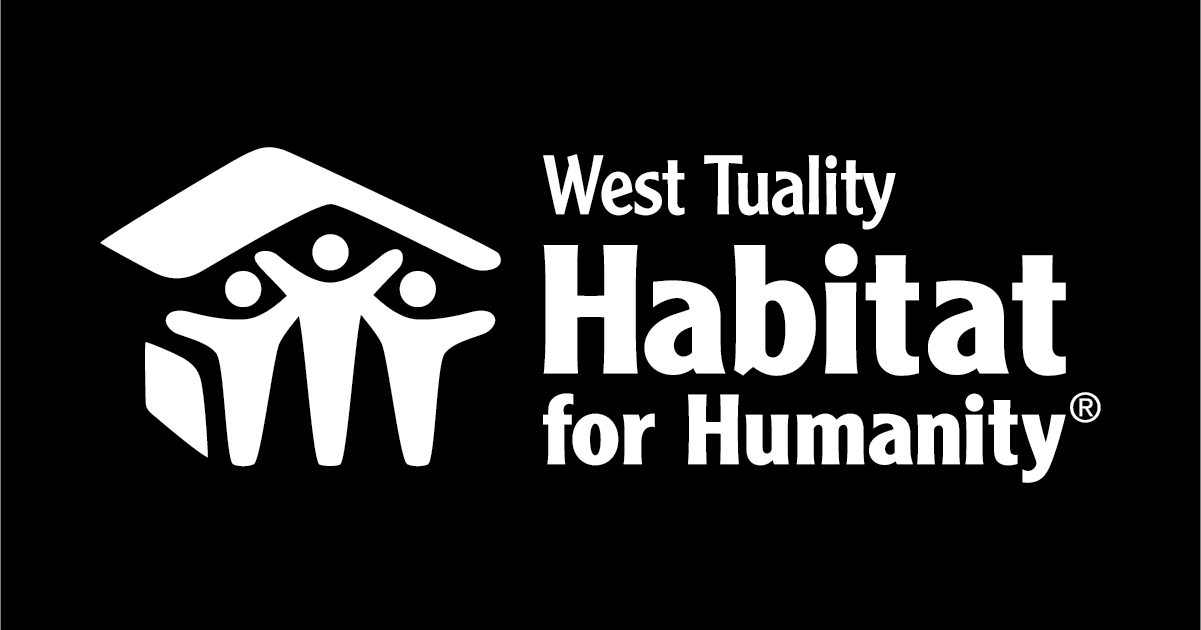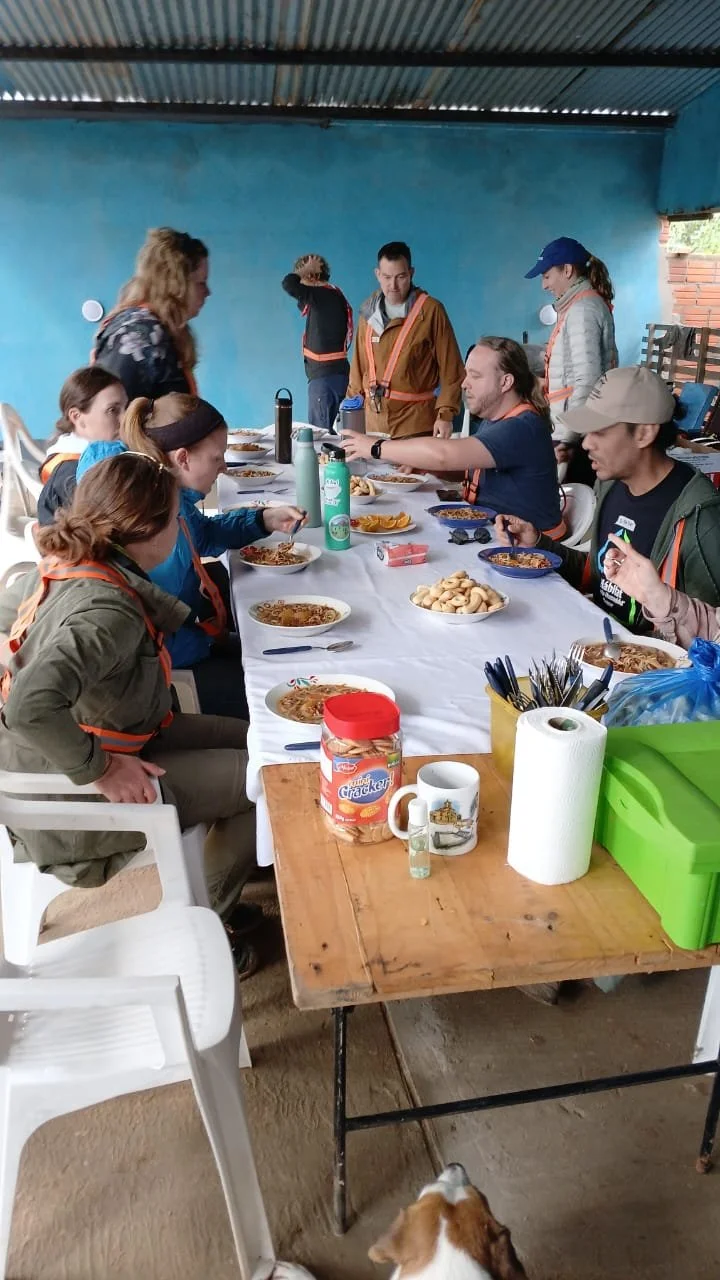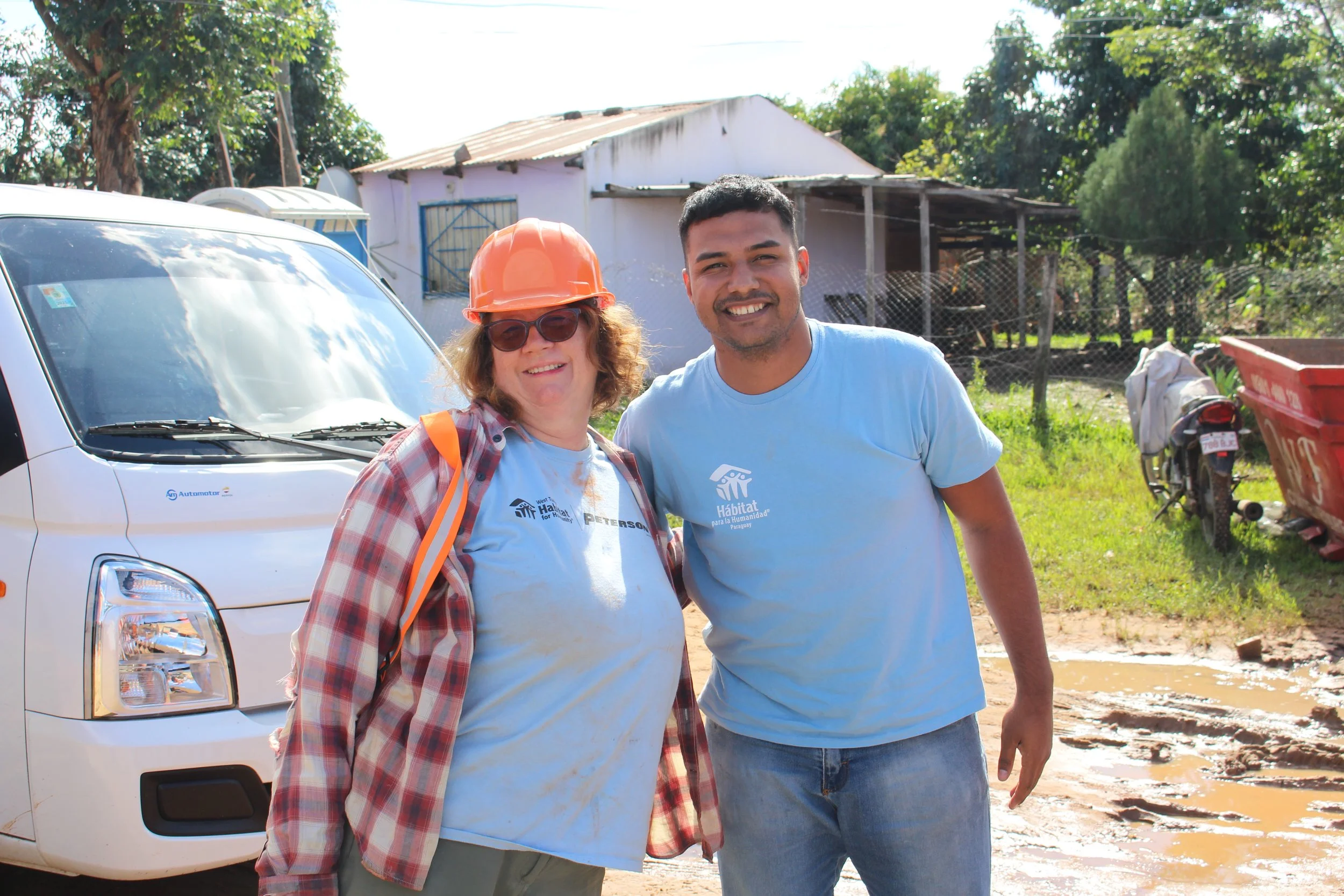West Tuality Habitat employee volunteers in Paraguay via the Global Village program
Jayne Cravens works part-time for West Tuality Habitat for Humanity, providing marketing and outreach services regarding our affiliate’s activities and the Forest Grove ReStore. This is her first-person account of her experience as a volunteer in Paraguay via Habitat for Humanity’s Global Village program.
Last month, in May 2025, I went through an extraordinary experience: I got to participate in Habitat for Humanity’s Global Village program in Paraguay. I have a few of my photos from this trip at the end of this blog.
The Global Village program mobilizes volunteers to work with local communities and local Habitat organizations to address housing needs in various locations around the world, mostly in countries that are listed in the United Nations Development Programme’s (UNDP) Human Development Index with a high number - meaning a large percentage of the population in the country has significant challenges regarding people’s health, access to education and access to a decent standard of living. Through this program, local Habitat organizations in impoverished areas receive much needed funding, per the fees paid by international volunteers, there's an increased understanding by volunteers of home ownership challenges globally and the role Habitat for Humanity plays in addressing such, volunteers become better advocates for Habitat’s vision where everyone has a decent place to live, and people from different cultures get to come together and work side-by-side, leading to greater understanding and appreciation of each other. I wrote about this program last month in a blog here on our web site.
Once I was invited to participate by this group's team leader, I had to arrange for and cover all transportation costs to and from the country myself. I also had to either fundraise or pay a $2000 program fee. I am so grateful to my friends who contributed! This fee from each volunteer becomes a part of the overall funding that helps pay local construction experts to guide volunteers in the Global Village program and to continue to work long after volunteers are gone, to pay local staff to support volunteers, and for building materials (bricks, sand, cement and more). And to be clear: no funding was provided by West Tuality Habitat for Humanity for this trip (the vast majority of your locally-donated funds stay local, with the exception of the small percentage tithed to Habitat for Humanity International).
The home we volunteers worked on in Paraguay is for a family of six, all women. The head of the household is 49 years old and a single mother. She works in another family’s home, receiving a monthly income of approximately 1,600,000 guaraníes (USD 198). She lives with her mother and her elderly aunt, both of whom have significant mobility issues and one of whom has the first symptoms of Parkinson's disease. She has a daughter, 30 years old, who works at a service station, another daughter, 20, who stays home to take care of her grandmothers, a 17 year old who is about to finish high school, and one other daughter. None of the family members have had access to university studies, and the older adults have reached only the ninth grade of education. Currently, the family income amounts to approximately 3,800,000 guaraníes (USD 470).
This all-women household has been part of the San Cayetano community for the past seven years, and their small wooden home is in a precarious condition. The land where they live does not flood, but the road in front of it does, as does some of the land around it, and they do have standing water on their property after a hard rain. Their wooden home was provided by Techo, an NGO that builds temporary housing. It has one room: space for a common bedroom for the whole family and a space for the kitchen. They also have a separate bathroom, with a shower and flushing toilet, with a concrete foundation and walls of brick. This bathroom, by far the most expensive room of the house, will be incorporated into their permanent brick house.
For a week, Monday through Friday, from 9 to 4, except for the ground breaking ceremony, the end-of-week ceremony and lunches each day, the volunteers and contractors worked non-stop: shoveling and hauling sand and gravel for the cement, retrieving water for the mortar, hauling buckets of cement and mortar, shoveling clay dirt out of where the foundation would go and specially ordered dirt back in, carrying rocks, setting bricks, creating rebar cages and on and on. Our goal was to finish the foundation for a four room home in just five days. And we did it!
Starting on Tuesday, each day when we arrived at the site, I would greet each member of the family or neighborhood that had come out to watch us work. What a wonderful way to begin the work day, holding hands, wishing each other a good day and kissing each other on the cheek. The mother and a daughter joined women neighbors to prepare our lunch each day, and we would all stop work at once to eat communally. One day, the mother hosted a short cooking class for us, right on site.
There were 11 volunteers in all. Five were employees of Habitat for Humanity International, and all but three - and one of those two was me - were veterans of the Global Village program. I have to admit to feeling quite lost the first two days in particular: the other volunteers jumped right in and seemed to know exactly what to do. It took me longer than I would have liked to find my work rhythm and feel like I was even getting close to the productivity of the other volunteers. While dancing and singing did sometimes break out among volunteers, mostly, we worked, non-stop.
We had to get the house foundation done in a week, and I'm so pleased to say that we did. Once we had widened and deepened the trench that outlined the house and went down the middle, and once the dirt was pounded down, a layer of plastic was laid down in the trench, then a layer of cement with gravel in it on top of that. Then came the rocks - huge, jagged rocks. These were placed inside the trench and smaller rocks and mortar were used to fill in all the gaps. More mortar was put on the top once the rocks were almost even with the top of the trench. And that was just on day one!
The next days were focused on removing the dirt we didn't want, adding in the dirt we did, constructing rebar boxes, creating brick-lined walls for both sides of the foundation, laying the rebar boxes inside and then filling the brick trenches with mortar.
Added challenge: on the second night, a torrential storm washed away most of the sand, gravel and brick mounds we were going to use in the work for the rest of the week. So more had to be ordered and delivered. We used this time to construct the rebar boxes - the staff at Hábitat para la Humanidad Paraguay had planned for this activity for a day that we would probably be rained out.
The staff at Hábitat para la Humanidad Paraguay and the professional construction workers that supported us were extraordinary. Our briefings provided the absolute essential information we needed to have safe, productive days, and the professional construction staff were happy to include us in the work, with an endless amount of patience as we took on tasks. I wanted to really help, not be in the way, and at the end of the week, I asked one of the workers to be honest with me: ¿En realidad, los ayudamos? ¿O nosotras hicimos más trabajo para su? He said no, we did not make more work for them, we really did help. In fact, the head construction worker said we did a month's work in a week.
Here’s a very short video on Instagram that provides highlights of the entire week.
The two days before we began work, and the evenings, provided more than enough time to get to know Asunción, Paraguay, and to take a trip to Areguá.
Local volunteers will now begin to work on site for the family we supported in the San Cayetano community. The staff at Hábitat para la Humanidad Paraguay will update their Facebook and Instagram accounts about this family, so we - and YOU - will be able to see the progress and the finished house.
What I loved most about this experience is that this program and both the volunteers’ participation and financial support are essential to this family getting a home. Our participation wasn’t just a show and our labor really was essential. We also did not displace local workers through our unpaid labor; in fact, our fees helped hire local staff. I also got the cultural experience I so desire whenever I travel. And I loved working with the Habitat Paraguay staff - beyond measure - and have learned things I hope to apply in the work of West Tuality Habitat. I can honestly say that this is an ethical, impactful program, and I am proud to have been a part of it.
Back here in Forest Grove, Oregon, I hope that we can incorporate the practices of Habitat Paraguay in making sure volunteers feel as supported and prepared and that they feel like they've made a real difference by the end of a day of work. Will dancing and singing also be incorporated? Time will tell…
I also have an even greater appreciation for Habitat for Humanity being a truly global organization, one I’m not sure I entirely understood before this experience. I feel an even deeper connection to Habitat for Humanity’s work in advocating for improved housing policies so that everyone has a decent place to live. Building housing and undertaking critical home repairs for vulnerable home owners is part of the solution, but that’s not enough to meet the need. Habitat needs people - and that includes you, dear reader - to promote sustainable and inclusive policy solutions to ensure everyone has access to adequate and affordable housing. West Tuality Habitat regularly posts on our social media channels about things happening at the local and state level; be sure to follow Habitat for Humanity International for information on policy advocacy on the national level. And read more about Habitat’s advocacy campaigns and how you can get involved.
The option for independent volunteers to join Habitat’s Global Village teams with whom they do not already have an association is not currently available, but you should sign up at the Habitat web site for updates in case this changes. And this does NOT mean you can’t participate! Habitat is seeking people to become Global Village Team Leaders, who will then recruit and organize their own teams. Candidates need to be from organized groups, such as university classes or clubs, social clubs, communities of faith, volunteers or staff from local Habitat affiliates, employees from a company, etc. Candidates take the Global Village online trainings and then lead their organized group of co-workers, club members, students, congregation members or other association on a Global Village program trip abroad. Visit the Global Village team leader FAQ to find out if leading a team is right for you. Also see the blog I wrote last month about the program. And if, after doing all of that, you still have questions, contact me at West Tuality Habitat and I can tell you want, from my observation, being a team leader is like.
New Global Village build dates for 2026 will be released in July! Now is the perfect time to take the team leader trainings and to talk to your co-workers, fellow students, fellow members of your community of faith, other members of your civic club, or your local Habitat affiliate where you already volunteer, etc., about this program, to generate interest among your associates for possibly joining your team. That will help you to be ready to book early and secure your team’s spot in the Habitat program. Global Village groups usually consist of up to 16 individuals. Potential participants should understand that each Global Village volunteer raises funds among their associates or contributes a donation ranging from US$1,625-$2,700 that supports Habitat’s housing programs. Volunteers are responsible for paying for their own on-site accommodations (arranged by Habitat), meals, ground transportation and transportation to the country, as well as arranging for any necessary visas.
What’s also important for participation is your health: you should be prepared to work a full six hours, with a break every 40 minutes and a break in the middle for lunch. The work is intense, very physical and requires a lot of lifting, carrying and bending. You should know your physical limits and know how to self manage yourself to prevent injuries that can come from pushing yourself too far and not taking breaks.
The more flexible you can be in terms of your diet and the temperature you can work in, the less you will be challenged by this experience. Layered clothing is vital, as is following directions. Drinking water is provided on site, but take a water bottle, even a large plastic water bottle, so you don’t have to use (and discard) plastic cups whenever you need a drink. Our site had a regularly serviced portable toilet.
For the Paraguay worksite, I took five t-shirts, one for each day, with the intent on leaving them all behind: our Habitat Paraguay liaison, the amazing Diego, arranged for these clothes to go to families living next to a landfill, who spend all of their time going through the refuse to find items to sell. I also took a pair of pants I didn't mind getting ruined (they did not get ruined, remarkably, and have returned with me to the USA) and shoes that could handle the rough work conditions but that I also wouldn't mind leaving behind (so glad I saved those long worn out trail running shoes!). I also took a long sleeved shirt, but just one - wish I’d brought two! I also packed just a few clothes for evenings and for the days before and after the main part of the trip. Altogether, everything I took fit into two carryons, which was important since the journey to Paraguay had me on three different planes in four different airports, over 20 hours.
Below are just a few photos from my experience in Paraguay. I remain so grateful for the invitation to participate from Stephanie Carey Yeargan of the Habitat for Humanity International office, for the support of the staff of Hábitat para la Humanidad Paraguay, who will be in my heart forever, and for the hospitality of the family we built this house for, who made us all feel oh-so-welcomed.













